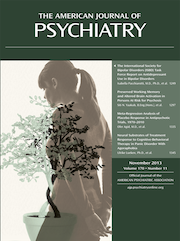Anatomical and Functional Brain Abnormalities in Drug-Naive First-Episode Schizophrenia
Abstract
Objective
The authors sought to explore whether anatomical and functional brain deficits are present in similar or different brain regions early in the course of schizophrenia, before antipsychotic treatment, and whether these deficits are more severe or otherwise different in patients with prominent negative symptoms.
Method
A total of 100 drug-naive first-episode schizophrenia patients and 100 matched healthy comparison subjects underwent structural and resting-state functional MRI scanning. Gray matter volume and amplitude of low-frequency fluctuations during resting-state functional studies were measured.
Results
Group comparisons of gray matter volume showed significant differences mainly in thalamo-cortical networks, while alterations in the amplitude of low-frequency fluctuations were observed in fronto-parietal and default mode networks. Thus, different brain regions had alterations in gray matter volume and resting state physiology. These changes did not correlate with the duration of untreated illness, nor with acute clinical symptom severity. Patients with prominent negative symptoms had greater regional alterations in brain anatomy, particularly in the left dorsolateral prefrontal cortex, while the pattern of functional alterations was unrelated to severity of negative symptoms.
Conclusions
Anatomical and resting-state functional deficits were observed in different brain regions, indicating that anatomical and functional brain abnormalities are significantly dissociated in the early course of schizophrenia. The lack of association of these abnormalities with illness duration and episode severity suggests that these anatomical and functional changes may be early-evolving features of the illness that are relatively stable early in the course of illness. The different structural deficits of regional gray matter observed in patients with prominent negative symptoms may provide unique insight into the early regional neuropathology of this symptom dimension in schizophrenia.



